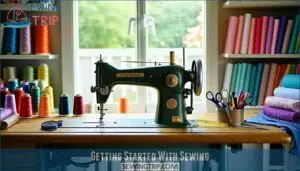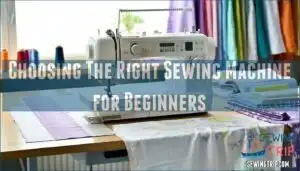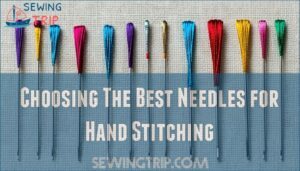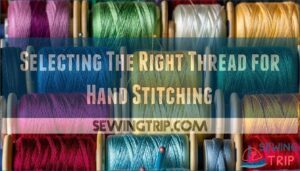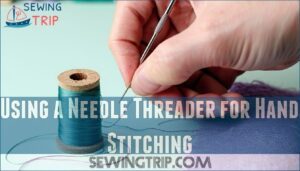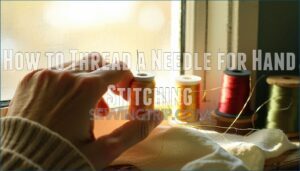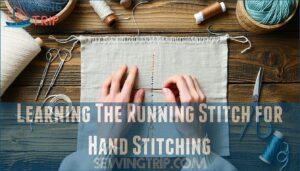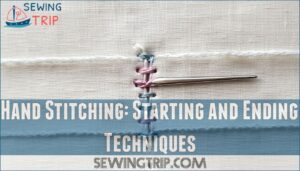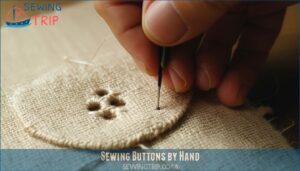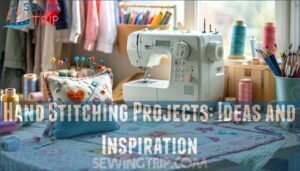This site is supported by our readers. We may earn a commission, at no cost to you, if you purchase through links.
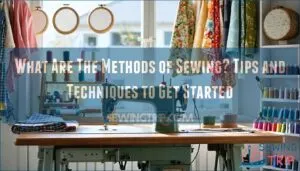
Hand stitching is great for detail work, small repairs, or adding personal touches like embroidery.
Techniques like the running stitch, backstitch, and whipstitch are key basics.
Machine sewing, on the other hand, is faster and perfect for making clothes, quilts, or home décor.
You’ll use straight stitches, zigzags, or even decorative patterns.
Each method requires the right tools—needles, thread, and fabric choice can make or break your project.
Whether you’re sewing a button or crafting an outfit, understanding these methods opens up endless creative possibilities.
Ready for more tips?
Table Of Contents
- Key Takeaways
- Getting Started With Sewing
- Choosing The Right Sewing Machine for Beginners
- Essential Fabrics and Accessories for Sewing
- Basic Sewing Techniques for Machine Sewing
- Hand Stitching: Tips and Tricks
- Hand Stitching: Starting and Ending Techniques
- Sewing Buttons by Hand
- Sewing Sequins by Hand
- Hand Stitching Projects: Ideas and Inspiration
- Frequently Asked Questions (FAQs)
- Conclusion
Key Takeaways
- Hand stitching is perfect for detailed work, repairs, and personal touches, with basic techniques like running stitch, backstitch, and whipstitch.
- Machine sewing is faster and great for complex projects like clothing or quilts, using straight, zigzag, or decorative stitches.
- Choose the right tools—needles, thread, and fabric type make a big difference for every project.
- Practice basic techniques like threading, tension control, and stitch selection to improve your sewing skills over time.
Getting Started With Sewing
Starting your sewing journey? It’s easier than you think!
Starting your sewing journey is simple—set up a workspace, grab your tools, and create magic with every stitch!
First, set up a dedicated sewing workspace with essential tools like sharp scissors, a tape measure, and a reliable machine.
Begin with simple projects using basic patterns and beginner-friendly fabrics like cotton.
Pay attention to fabric selection—lightweight for tops, medium for jeans, and heavier for coats.
Plan projects carefully and gather matching threads and needles.
Follow sewing tutorials or sewing tips online to master basic sewing techniques.
With practice, you’ll stitch like a pro!
Choosing The Right Sewing Machine for Beginners
Choosing your first sewing machine can feel like finding your way through a maze, but it’s easier if you know what factors to evaluate. Think of it like picking a car—you want something reliable, user-friendly, and suited to your needs.
Start with these steps:
- Machine Features: Look for essential functions like straight and zigzag stitches, adjustable speed, and an easy threading system. Fancy extras? Skip them for now.
- Budget Considerations: Set a price range. Beginner machines don’t have to break the bank. Stay practical, but don’t sacrifice quality.
- Intended Projects and Space Requirements: Planning small crafts or bigger garments? Compact models are great if space is tight.
Research well, read sewing machine tutorials, and explore reputable brands. Many people search for sewing machine beginner options online. The right machine will kickstart your sewing journey!
Essential Fabrics and Accessories for Sewing
Before jumping into a project, think about fabric types that match your plan. Lightweight cotton is forgiving for beginner fabrics, while denim or canvas may require patience.
Thread selection matters too—cotton thread suits delicate fabrics, but heavier materials need polyester blends. For many projects, choosing the right fabric is critical for success.
Equip yourself with sharp cutting tools and sewing needles in various sizes; each fabric demands the right match! Don’t forget measuring tools like a flexible tape measure. Stocking these sewing essentials makes every stitch smoother, leaving less room for frustration.
Basic Sewing Techniques for Machine Sewing
Machine sewing opens doors to endless projects. Understanding your sewing machine’s features makes all the difference. Mastering basics like machine threading, tension adjustment, and stitch selection sets you up for success.
A few tips:
- Use presser feet to guide fabrics properly and maintain consistent seam allowance.
- Adjust tension to avoid puckered stitches or loose threads.
- Follow patterns closely for accuracy.
With practice, these simple sewing techniques can transform fabric into something amazing!
Hand Stitching: Tips and Tricks
Hand stitching is a timeless skill that lets you tackle everything from quick fixes to detailed projects with ease.
A timeless skill, hand stitching turns quick fixes into masterpieces, adding charm and personal touch to every fabric project.
With the right tools and a little practice, you’ll create strong, neat stitches in no time.
Choosing The Best Needles for Hand Stitching
In the context of hand stitching, using the right sewing needles can make or break stitch quality.
Match needle size to fabric weight—sharps work for most fabrics, while ballpoint needles suit knits.
Needle types like Milliners are great for decorative stitches, and trusted needle brands like John James guarantee durability and precision.
Needle size impacts stitch quality, so it is crucial to Find your perfect match, and stitching gets seamless!
Selecting The Right Thread for Hand Stitching
The right thread makes or breaks your hand stitching. Consider these tips:
- Thread Fiber Types: Use polyester for durability or silk for luxury.
- Thread Weight Matters: Thick threads suit heavy fabrics; light ones for delicate work.
- Color Matching Guide: Pick a matching or contrasting color.
- Specialty Thread Uses: Try waxed thread for leather.
- Thread options are widely available.
- Thread Storage Tips: Keep threads organized, tangle-free.
Using a Needle Threader for Hand Stitching
If threading a needle feels like wrestling with an invisible thread ninja, a needle threader can save your sanity.
These handy tools simplify hand stitching, especially if you’re working with smaller needles or struggling with vision.
Simple wire threaders are the most common, but other threader types, like handheld or automatic versions, can up your game.
To use one, slip the threader’s wire loop through the needle’s eye, pull your thread through the loop, and gently tug it back.
Voilà—your needle is ready!
Threader benefits are hard to ignore, but keep in mind their limitations, like wear and tear.
Regular threader maintenance will keep your sewing techniques frustration-free.
How to Thread a Needle for Hand Stitching
Threading a needle for hand stitching isn’t as tricky as it seems with a few tips.
First, match your needle eye size to the thread thickness choice—too thick, and you’ll struggle.
Snip the thread’s end cleanly, then moisten it slightly for easier handling.
If threading difficult needles frustrates you, try using a needle threader; it’s like a best friend that saves time.
Knotting thread ends secures your stitches, so don’t skip it.
Good lighting and visibility help immensely—sit near a window or use a lamp.
A little practice, patience, and these tricks will have you sewing like a pro!
Learning The Running Stitch for Hand Stitching
Learning the running stitch is your first step into hand stitching magic.
Adjust your stitch length depending on the fabric choice—shorter stitches for curves, longer for straight seams. Keep thread tension snug but not tight.
This basic stitch has endless applications: gather fabric, sew curved seams, or repair tears. A key aspect is mastering the running stitch technique for various embroidery projects.
Practice on scraps to master this timeless sewing technique, and understand the importance of the running stitch technique in embroidery.
Hand Stitching: Starting and Ending Techniques
Starting your hand stitching project the right way makes all the difference. Use knotting techniques to secure threads and prevent unraveling. Keep the thread tension even to avoid puckering and guarantee neat sewing stitches.
- Create invisible starts with a secure double knot.
- End with a securing stitch and trim thread tails close to the fabric.
- Match needles and threads carefully for smoother hand stitching.
Neat endings and precise starts bring polish to your work, building confidence with every stitch!
Sewing Buttons by Hand
Sewing buttons by hand can feel like crafting small works of art. Begin with thread matching your fabric—polyester blends work well.
For two-hole or four-hole buttons, sew in an "X" or parallel lines for secure attachment. Shank buttons require creating a thread shank underneath for durability.
Button placement is key, so align carefully before stitching. Use reinforcement stitching to strengthen heavy-use buttons.
With steady hands and refined sewing techniques, mastering hand sewing stitches for buttons becomes rewarding, adding charm and function to your clothing.
Sewing Sequins by Hand
Adding sequins by hand gives life to your fabric, turning basic designs into stunning embellishments.
Start by choosing the right needle and matching thread—double the thread for strength.
Use small “up-and-down” motions to secure sequins, making sure each stitch is snug but not too tight.
Overlap sequins slightly for a polished look.
Delicate fabrics may need stabilizing before sewing.
Experiment with sequin types and pattern designs, and remember, mess-ups are part of improving your sewing skills.
Creativity always shines!
Hand Stitching Projects: Ideas and Inspiration
Ready to explore creative hand sewing projects? It’s amazing what you can make with just a needle and thread!
Whether you’re into embroidery projects or simple decorative crafts, here are a few ideas to try:
- Felt Pincushion – Turn felt scraps into a cute, sturdy pincushion.
- Fabric Embellishments – Add detail with embroidery stitches like chain or blanket stitch.
- Applique Ideas – Layer fabrics to create fun designs.
- Quilting Inspiration – Hand-stitch patchwork for small quilts.
- Mending Techniques – Repair clothes with stylish, visible stitching.
Consider how hand sewing improves coordination, making it a beneficial hobby. Enjoy mastering these sewing projects!
Frequently Asked Questions (FAQs)
What are the different sewing techniques?
You’ve got techniques like hand stitching for detail and machine sewing for speed.
Master stitches like running, backstitch, zigzag, and French seams.
Each method suits different fabrics and projects—precision and patience make all the difference!
How do you get better at sewing techniques?
Did you know 65% of beginner sewists improve faster by practicing daily?
Start small—perfect a basic stitch like the running stitch.
Experiment with fabrics, use sharp tools, and don’t fear mistakes—they’re your best teacher!
How do I learn sewing by hand?
Start by mastering basic stitches like running, basting, and backstitch.
Practice on scrap fabric, keep stitches even, and follow tutorials online.
Take it slow, and soon you’ll fix seams and create DIY magic!
What is the easiest sewing technique to learn?
The running stitch is the easiest to learn.
It’s simple, quick, and perfect for beginners.
Just weave your needle in and out of the fabric, keeping stitches even.
It’s like drawing dots with thread!
How do I start hand sewing?
Don’t worry if it feels tricky at first—grab a needle, thread it, and tie a knot at the end.
Practice a simple running stitch on scrap fabric to build confidence.
Mistakes? They’re just practice!
What are the 5 basic sewing processes?
The five basic sewing processes include stitching seams for joining fabrics, hemming edges to prevent fraying, adding decorative or functional details.
Finishing seams for durability, and mending or altering garments to fix issues or improve fit.
What is the method of sewing?
Sewing is like building with thread and fabric.
You hand-stitch for control and detail, like a running stitch or backstitch, or use machines for speed and precision with straight, zigzag, or decorative stitches.
What are the 5 classification of sewing?
Sewing is classified into five main types: hand sewing for precision, machine sewing for speed, decorative sewing for design, and technical sewing for industrial needs.
Embroidery, adding flair with intricate stitches and patterns.
What are the 10 types of sewing professionals?
Picture sewing pros as threads in a masterpiece.
From fashion designers to tailors, pattern makers to seamstresses, quilting artists, embroiderers, textile experts, upholsterers, costume designers, and alterations specialists—they each stitch creativity into purpose.
They bring purpose to the work they do, making each stitch count in the final product.
What are the alternative methods to sewing?
You’ve got plenty of options beyond sewing, like using fabric glue, iron-on adhesive, stapling, or even fusible webbing.
These methods are quick, require less effort, and great for no-sew projects or mending.
Conclusion
In the context of sewing, there’s more than one way to skin a cat!
Whether you prefer the precision of hand stitching or the speed of machine sewing, knowing the methods of sewing can transform your projects.
Pick sturdy needles, the right thread, and fabric that suits your vision.
Start small with simple stitches or plunge into creative designs.
With practice, tools, and patience, you’ll master sewing’s endless possibilities in no time.
Happy stitching!

